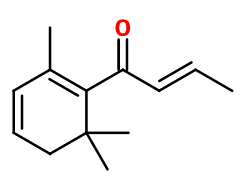Damascenone-Beta®
Naturelle - Synthétique
Fruity > Berries > Rosy > Earthy

Crédits photo: ScenTree SAS
Other names :
Fermentone® ; (E)-1-(2,6,6-trimethyl-1-cyclohexa-1,3-dienyl)but-2-en-1-one ; Floriffone ; Roastarome ; Rose ketone-4 ; Rosenone ; Trimethyl cyclohexadienyl butenone
Volatility :
Heart/Base
Uses in perfumery :
Damascenone-Beta® brings a fruity nuance for rosy notes. Gives a ''baked apple '' effect.
Natural availability :
Damascenone-Beta® is present in small quantities in Damask Rose Absolute and Damask Rose EO (and other roses), from which it can be extracted. It is also present in Clary Sage Absolute and salvia officinale among others, always in very small proportions.
Year of discovery :
First rose ketones were discovered in 1965, by chemists P. Ruzicka and Dr. Demole, by analyzing Damask Rose Absolute. This opened the way to synthesize a major molecule category of the perfume industry.
Other comments :
Data not available.
Price Range :
€€€€
Stability :
Stable in perfumes and diverse functional bases

Crédits photo: ScenTree SAS
- Molecular formula :
- C13H18O
- Molecular Weight :
- 190,29 g/mol
- Density :
- 0,946
- Flash Point :
- >100°C
- Fusion Point :
- 2°C
- Appearance :
- Colorless to pale yellow liquid
- Log P :
- 3,4
- Boiling Point :
- 199°C
- Detection Threshold :
- 0,0007 to 0,009 ppb
Synthesis route :
Damascenone-Beta® is part of the ''rose ketones '' family, present in a small amount in Damask Rose Absolute, while playing an important role in their smell. Rose ketones are synthesized from the appropriate derivative of cyclogeranic acid (ester, halide, ...). A reaction of this derivative with an allyl magnesium halide followed by a pyrolysis, allows to obtain the desired compound by rearranging the double bond of the branched chain.
Synthesis precursor :
Damascenone-Beta® is not a precursor to the synthesis of another compound of olfactory interest.
Isomerism :
There is an isomer of Damascenone-Beta® called Damascenone-Alpha®. Its smell is similar but the location of the double bonds in the ring is not the same (1,3 positions for beta and 2,4 positions for alpha).
Cyclamen Aldehyde is a constitutional isomer of Damascenone-Beta, although its smell is completely different, as it is very marine, floral and aldehydic.
- EINECS number :
- 245-833-2
- FEMA number :
- 3420
- JECFA number :
- 387
- FLAVIS number :
- 07.108
- Allergens :
- This ingredient does not contain any allergen.
- IFRA :
- This ingredient is restricted by IFRA
- Restriction type :
- RESTRICTION
- Cause of restriction :
- DERMAL SENSITIZATION
- Amendment :
- 49
- Comments :
- The above limits apply to Rose Ketones used individually or in combination. The sum of concentrations of Rose ketones isomers should not exceed the maximum concentration levels established by this Standard.
- Quantitative limit on the use :
-
Cat.1 Cat.2 Cat.3 Cat.4 Cat.5A Cat.5B Cat.5C Cat.5D Cat.6 0,0077 % 0,0023 % 0,046 % 0,043 % 0,011 % 0,011 % 0,011 % 0,011 % 0,025 % Cat.7A Cat.7B Cat.8 Cat.9 Cat.10A Cat.10B Cat.11A Cat.11B Cat.12 0,088 % 0,088 % 0,0045 % 0,084 % 0,3 % 0,3 % 0,17 % 0,17 % No Restriction
This ingredient is not restricted for the 48th amendment
To learn more about IFRA's standards : https://ifrafragrance.org/safe-use/library
ScenTree is solely responsible for the information provided here.
Do you sell any of the raw materials? Would you like to let our users know?
Send an email to fournisseurs@scentree.co to learn about our advertising opportunities.
